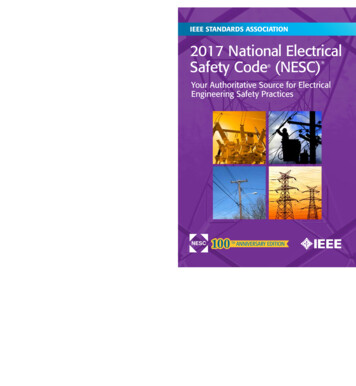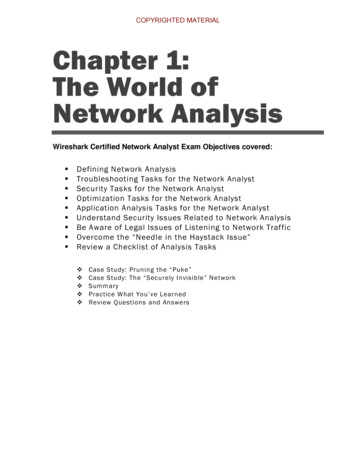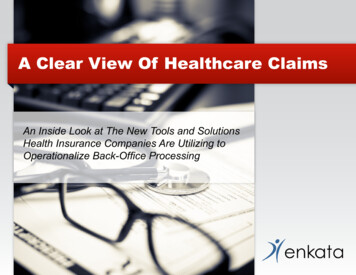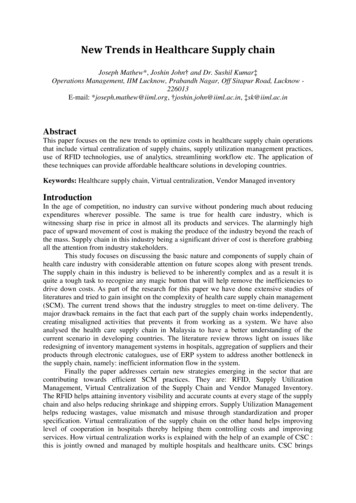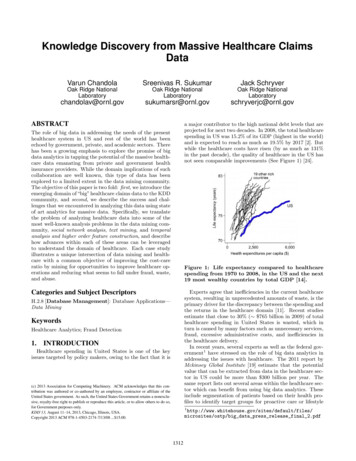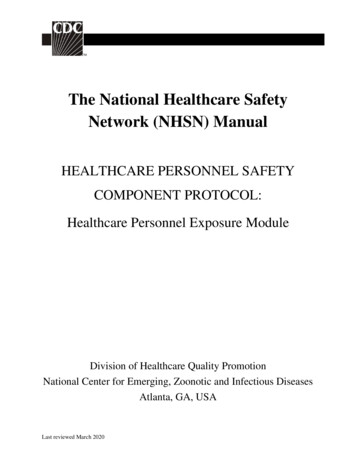
Transcription
The National Healthcare SafetyNetwork (NHSN) ManualHEALTHCARE PERSONNEL SAFETYCOMPONENT PROTOCOL:Healthcare Personnel Exposure ModuleDivision of Healthcare Quality PromotionNational Center for Emerging, Zoonotic and Infectious DiseasesAtlanta, GA, USALast reviewed March 2020
Table of ContentsChapterTitle1Introduction to the Healthcare Personnel Safety Component2Healthcare Personnel Safety Reporting Plan3Blood/Body Fluid Exposure Options (With and WithoutExposure Management)4Influenza Exposure and Treatment Option5Tables of Instructions6Key Terms7CDC Codes (Occupations, Devices and PEP Drugs)Last reviewed March 2020
Introduction to the HPS Component of NHSNIntroduction to Healthcare Personnel Safety Component of NHSNIn recent years, occupational hazards faced by healthcare personnel (HCP) in the United Stateshave received increasing attention. Although recommendations, guidelines, and regulations tominimize HCP exposure to such hazards have been developed, additional information is neededto improve HCP safety. In particular, existing surveillance systems are often inadequate todescribe the scope and magnitude of occupational exposures to infectious agents and noninfectious occupational hazards that HCP experience, the outcomes of these exposures andinjuries, and the impact of preventive measures. The lack of ongoing surveillance ofoccupational exposures, injuries, and infections in a national network of healthcare facilitiesusing standardized methodology also compromises the ability of the Centers for DiseasePrevention and Control (CDC) and other public health agencies to identify emerging problems,to monitor trends, and to evaluate preventive measures.The Healthcare Personnel Safety (HPS) Component of the National Healthcare Safety Network(NHSN) was launched in 2009. The component consists of two modules: 1) HealthcarePersonnel Exposure; and (2) Healthcare Personnel Vaccination. The Healthcare PersonnelExposure module includes: Blood/Body Fluid Exposure Only; Blood/Body Fluid Exposure withExposure Management; and Influenza Exposure Management. The Healthcare PersonnelVaccination module includes: Influenza Vaccination Summary.Data collected in this component of NHSN will help healthcare facilities, HCP organizations,and public health agencies to monitor and report trends in blood/body fluid exposures, to assessthe impact of preventive measures, to characterize antiviral medication use for exposures toinfluenza, and to monitor influenza vaccination rates among HCP. In addition, this surveillancecomponent will allow CDC to monitor national trends, to identify newly emerging hazards forHCP, to assess the risk of occupational infection, and to evaluate measures, includingengineering controls, work practices, protective equipment, and post-exposure prophylaxisdesigned to prevent occupationally-acquired infections. Hospitals and other healthcare facilitiesparticipating in this system will benefit by receiving technical support and standardizedmethodologies, including a web-based application, for conducting surveillance activities onoccupational health. The NHSN reporting application will enable participating facilities toanalyze their own data and compare these data with a national standard.Last reviewed March 20201-1
Healthcare Personnel Safety Reporting PlanHealthcare Personnel Safety Reporting PlanThe Healthcare Personnel Safety Monthly Reporting Plan Form (CDC 57.203) isused by an NHSN facility to inform CDC which healthcare personnel safety modules areused during a given month. This guides NHSN on what data to expect from the user in agiven month and allows CDC to select the data that should be included into the aggregatedata pool for analysis. Each participating facility is to enter a monthly plan to indicate themodule to be used, if any, and the exposures and/or vaccinations that will be monitored.A plan must be completed for every month that data are entered into NHSN,although a facility may choose “No NHSN Healthcare Personnel Safety ModulesFollowed this Month” as an option. The Instructions for Completion of HealthcarePersonnel Safety Monthly Reporting Plan Form includes brief instructions for collectionand entry of each data element on the form.Last reviewed March 20202-1
Blood/Body Fluid Exposure OptionBlood/Body Fluid Exposure OptionIntroduction:Transmission of bloodborne pathogens [e.g., Hepatitis B virus (HBV), Hepatitis C virus (HBC),Human Immunodeficiency Virus (HIV)] from patients to healthcare workers (HCW) is animportant occupational hazard faced by healthcare personnel (HCP). The risk of bloodbornepathogen transmission following occupational exposure depends on a variety of factors thatinclude source patient factors (e.g., titer of virus in the source patient’s blood/body fluid), thetype of injury and quantity of blood/body fluid transferred to the HCW during the exposure, andthe HCW’s immune status. The greatest risk of infection transmission is through percutaneousexposure to infected blood. Nevertheless, transmission of HBV, HCV, or HIV after mucousmembrane or non-intact skin exposure to blood has also been reported. The risk of transmissionof these pathogens through mucocutaneous exposure is considered lower than the risk associatedwith a percutaneous exposure.An estimated 385,000 percutaneous injuries (i.e., needlesticks, cuts, punctures and other injurieswith sharp objects) occur in U.S. hospitals each year. Prevention of occupational transmission ofbloodborne pathogens requires a diversified approach to reduce blood contact and percutaneousinjuries including improved engineering controls (e.g., safer medical devices), work practices(e.g., technique changes to reduce handling of sharps), and the use of personal protectiveequipment (e.g., impervious materials for barrier precautions). Since 1991, when the U.S.Occupational Safety and Health Administration (OSHA) first issued its Bloodborne PathogensStandard, the focus of regulatory and legislative activity has been on implementing a hierarchyof control measures. The federal Needlestick Safety and Prevention Act signed into law inNovember 2000 authorized OSHA’s revision of its Bloodborne Pathogens Standard to moreexplicitly require the use of safety-engineered sharp ens/). Other strategies to prevent infectioninclude hepatitis B immunization and postexposure prophylaxis for HIV and HBV. Strategies forprevention of percutaneous injuries are addressed in CDC’s Workbook for Designing,Implementing, and Evaluating a Sharps Injury Prevention Program ities are not required to collect data for exposures that involve intact skin or exposures tobody fluids that do not carry a risk of bloodborne pathogen transmission (e.g., feces, nasalsecretions, saliva, sputum, sweat, tears, urine and vomitus) unless these are visibly contaminatedwith blood. However, facilities that routinely collect data on such exposures may enter thisinformation into the system.(i) MethodologyOccupational exposures to blood and body fluids in healthcare settings have the potential totransmit HBV, HCV, or HIV. Use of the Blood/Body Fluid Exposure Option permits aLast reviewed March 20203-1
Blood/Body Fluid Exposure Optionhealthcare facility to record information about the exposure and its management. This option canbe used in any healthcare setting where there is potential for occupational exposure to blood andbody fluids among HCP. This option requires that data be entered into NHSN when exposuresoccur, as indicated in the Healthcare Personnel Safety Monthly Reporting Plan (CDC 57.203). Ingeneral, these data may be provided by the occupational health department in the facility or maybe provided by the infection control/epidemiology department, as appropriate. NHSN formsshould be used to collect all required data, using the definitions included for each data field.Blood/Body Fluid Exposure with or without Exposure ManagementA facility may choose to report exposure events alone or exposure events and subsequentmanagement and follow-up of each event, including administration of postexposure prophylaxis(PEP) to the HCW and any laboratory test results collected as part of exposure management.Settings: Any healthcare setting with the potential for occupational exposure to blood and bodyfluids.Requirements: Blood and body fluid exposures are to be reported as they occur during thecalendar year.Definitions: Bite: A human bite sustained by a HCW from a patient, other HCW, or visitor. Bloodborne pathogens: Pathogenic microorganisms that may be present in human blood andcan cause disease in humans. These pathogens include, but are not limited to hepatitis B virus(HBV), hepatitis C virus (HCV) and human immunodeficiency virus (HIV). HCW (Healthcare Worker): A person who works in the facility, whether paid or unpaid,who has the potential for exposure to infectious materials, including body substances,contaminated medical supplies and equipment, contaminated environmental surfaces, orcontaminated air. Healthcare worker is the singular form of healthcare personnel. HCP (Healthcare Personnel): A population of healthcare workers working in a healthcaresetting. Hollow-bore needle: Needle (e.g., hypodermic needle, phlebotomy needle) with a lumenthrough which material (e.g., medication, blood) can flow. Mucous membrane exposure: Contact of mucous membrane (e.g., eyes, nose, or mouth)with the fluids, tissues, or specimens listed below in "Occupational exposure." Non-intact skin: Areas of the skin that have been opened by cuts, abrasions, dermatitis,chapped skin, etc.Last reviewed March 20203-2
Blood/Body Fluid Exposure Option Non-intact skin exposure: Contact of non-intact skin with the fluids, tissues, or specimenslisted below in "Occupational exposure." Non-Responder to Hepatitis B vaccine: A HCW who has received two series of hepatitis Bvaccine is serotested within 2 months after the last dose of vaccine and does not have antiHBs 10 mIU/mL. Occupational exposure: Contact with blood, visibly bloody fluids, and other body fluids(i.e., semen, vaginal secretions, cerebrospinal fluid, synovial fluid, pleural fluid, peritonealfluid, pericardial fluid, and amniotic fluid, tissues, and laboratory specimens that containconcentrated virus) to which Standard Precautions apply and during the performance of anHCW’s duties. Modes of exposure include percutaneous injuries, mucous membraneexposures, non-intact skin exposures, and bites. Percutaneous injury: An exposure event occurring when a needle or other sharp objectpenetrates the skin. This term is interchangeable with “sharps injury.” Sharp: Any object that can penetrate the skin including, but not limited to, needles, scalpels,broken glass, broken capillary tubes, and exposed ends of dental wires. Sharps Injury: An exposure event occurring when any sharp object penetrates the skin. Thisterm is interchangeable with “percutaneous injury.” Solid Sharp: A sharp object (e.g., suture needle, scalpel) that does not have a lumen throughwhich material can flow.Reporting Instructions:Forms Description and Purpose: (See also: Tables of Instructions for Completion of HealthcarePersonnel Safety Component forms)All NHSN facilities following the Blood/Body Fluids Exposure Option:For either exposure reporting or exposure and exposure management reporting, a site shouldcomplete the following form: Healthcare Personnel Safety Component Facility Survey (CDC Form 57.200) – Usedto collect facility administrative data including total patient beds set up and staffed,annual inpatient days, number of patient admissions per year, number of annualoutpatient encounters, number of annual employee hours worked. The survey alsocollects annual data on the total number of HCP in selected occupational groups (fulltime equivalents and numbers of HCP, full or part-time). Healthcare Personnel Safety Monthly Reporting Plan (CDC Form 57.203) – Used tocollect data on which modules and which months a facility intends to participate inLast reviewed March 20203-3
Blood/Body Fluid Exposure Optionthe NHSN HPS Component. This form should be completed for every month that thefacility will participate in the HPS component.Exposure-Only Reporting:Those facilities participating in exposure-only reporting should complete the following forms: Healthcare Worker Demographic Data (CDC Form 57.204) – Used to collect data onHCW demographics such as gender and occupation for a healthcare worker who hasreported a blood or body fluid exposure. Exposure to Blood/Body Fluids (CDC Form 57.205) – Used to collect informationabout individual blood and body fluid exposure events. Sections I – IV should becompleted for all reported exposures. For percutaneous injuries with a needle or sharpobject that was not in contact with blood or other body fluids (as defined in“occupational exposure”) prior to exposure, the completion of Sections V-IX is notrequired.Exposure and Exposure Management Reporting:Facilities participating in exposure reporting and exposure management should complete theforms: Healthcare Worker Demographic Data (CDC Form 57.204) – Used to collect data onHCW demographics such as gender and occupation for a healthcare worker who hasreported a blood or body fluid exposure. Exposure to Blood/Body Fluids (CDC Form 57.205) – Used to collect informationabout individual blood and body fluid exposure events. Sections I – IV should becompleted for all reported exposures. If a facility chooses to follow the protocol forexposure management, Sections V – IX are also required. Healthcare Worker Prophylaxis/Treatment – BBF Postexposure Prophylaxis (PEP)(CDC Form 57.206) – Used to collect details of medications administered to ahealthcare worker following blood or body fluid exposure to HIV or HBV. Follow-Up Laboratory Testing (CDC Form 57.207) – Used to collect additionallaboratory testing results obtained on an HCW following a blood or body fluidexposure as part of exposure management. These serologic and other laboratoryresults are not required for exposure management but provide details for facilitiesopting for the long-term follow-up of exposures and evidence of seroconversion.Data Analysis:The use of the Blood/Body Fluid Exposure and Exposure Management Options will allow theparticipating NHSN site to estimate the nature, frequency, circumstances, and sequelae ofoccupational exposures to bloodborne pathogens (i.e., HBV, HCV, and/or HIV) throughLast reviewed March 20203-4
Blood/Body Fluid Exposure Optionpercutaneous injuries, bites, mucous membrane exposures or non-intact skin exposures. Inaddition, facilities can assess for changes in percutaneous injuries with the implementation ofsafety devices and other prevention strategies, the timeliness of initiating HIV postexposureprophylaxis (PEP) when indicated, assess the duration of HIV prophylaxis, and the proportion ofHCP experiencing adverse signs and symptoms after taking HIV PEP for occupationalexposures.Denominator data from the annual Facility Survey (CDC 57.200) can be used to estimaterates of exposures to blood/body fluids and to assess the effectiveness of engineering controls,work practices, and protective equipment in reducing exposure.References:The following CDC/PHS publications provide recommendations for management and follow-upof blood and body fluid exposures to HBV, HCV, and HIV: Updated U.S. Public Health Service Guidelines for the Management of OccupationalExposures to HBV, HCV, and HIV and Recommendations for Postexposure Prophylaxis(MMWR, June 29, 2001 / 50(RR11); 1-42)Updated U.S. Public Health Service Guidelines for the Management of OccupationalExposures to HIV and Recommendations for Postexposure Prophylaxis (MMWR,September 30, 2005 / 54(RR09); 1-17). (PEP medications are updated in NHSN asrequired)A Comprehensive Immunization Strategy to Eliminate Transmission of Hepatitis B VirusInfection in the United States. (MMWR), December 8, 2006 / 55(RR16); 1-25)Last reviewed March 20203-5
Influenza Exposure Management OptionInfluenza Exposure Management OptionIntroduction: The Advisory Committee on Immunization Practices (ACIP) recommends that allhealthcare personnel (HCP) and persons in training for healthcare professions should bevaccinated annually against influenza.[1,2] Persons who are infected with influenza virus,including those with subclinical infection, can transmit influenza virus to persons at higher riskfor complications from influenza. Vaccination of HCP has been associated with reduced workabsenteeism [3] and with fewer deaths among nursing home patients [4,5] and elderlyhospitalized patients.[5] Although annual vaccination is recommended for HCP and is a highpriority for reducing morbidity associated with influenza in healthcare settings, national surveydata have demonstrated vaccination coverage levels of 50% among HCP over severalvaccination seasons.[1]Although annual vaccination with the seasonal influenza vaccine is the best way to preventinfection, antiviral drugs can be effective for prevention and treatment of influenza. When HCPhave not been vaccinated or are exposed to an influenza strain with no vaccine coverage (i.e.,non-seasonal), a plan for anti-viral chemoprophylaxis and treatment could be implemented.Influenza Exposure Management OptionUse of the Influenza Exposure Management Option permits a healthcare facility to recordinformation on antiviral medication use for chemoprophylaxis or treatment without reportinginfluenza vaccination. It can be used in any healthcare setting. This option includes reporting ofindividual-level antiviral medication use for chemoprophylaxis or treatment after exposure toinfluenza. The reason for antiviral medication use can be attributed to either seasonal or nonseasonal influenza. Use of this option will allow facilities and CDC to measure antiviralmedication use related to the prevention and treatment of influenza.Settings: Any healthcare settingsRequirements: Surveillance for influenza in the healthcare facility is to be conducted during thevaccination season.Definitions: HCW (Healthcare Worker): A person who works in the facility, whether paid or unpaid,who has the potential for exposure to infectious materials, including body substances,contaminated medical supplies and equipment, contaminated environmental surfaces, orcontaminated air. Healthcare worker is the singular form of healthcare personnel. HCP (Healthcare Personnel): The entire population of healthcare workers working in ahealthcare setting.Last reviewed March 20204-1
Influenza Exposure Management Option Non-seasonal influenza vaccine: A vaccine for additional/novel influenza virus strains(e.g., 2009 H1N1) not included in the seasonal influenza vaccine which may or may not beoffered on an annual basis. Seasonal influenza vaccine: A vaccine for seasonal influenza virus strains that is offered onan annual basis. Severe adverse reaction to antiviral medication use for influenza chemoprophylaxis ortreatment: Adverse reactions severe enough to affect daily activities and/or result in thediscontinuation of the antiviral medication. Vaccination season: A 12-month period starting from July 1 of a year – June 30 of thefollowing year.Reporting InstructionsForms Description and Purpose: (See also: Tables of Instructions for Completion of HealthcarePersonnel Safety Component forms)All NHSN facilities following the Influenza Exposure Management Option:NHSN participants should complete the following forms: Healthcare Personnel Safety Component Facility Survey (CDC 57.200) – Used to collectfacility administrative data including total patient beds set up and staffed, annualinpatient days, number of patient admissions per year, number of annual outpatientencounters, number of annual employee hours worked. The survey also collects annualdata on the total number of HCP in selected occupational groups (full-time equivalentsand numbers of HCP, full or part-time). Numbers of HCWs for at least one nurseoccupation (e.g., registered nurse, nurse midwife) and one physician occupation (i.e.,intern/resident, fellow, attending physician) are required. All other fields are optional forthe Selected HCW Occupational Groups; you may enter 0 for these optional fields. Healthcare Personnel Safety Monthly Reporting Plan (CDC 57.203) – Used to collectdata on which modules and which months a facility intends to participate in the NHSNHPS Component. This form should be completed for every month that the facility willparticipate in the HPS Component. Healthcare Worker Demographic Data (CDC 57.204) – Used to collect data on HCWdemographics such as gender and occupation for each individual HCW. This form also isused optionally to collect information about immune status for certain vaccinepreventable diseases (e.g., measles, mumps, rubella).Last reviewed March 20204-2
Influenza Exposure Management OptionInfluenza Exposure Management Reporting:Facilities participating in influenza exposure management reporting for antiviral medication useshould complete the following form: Healthcare Worker Prophylaxis/Treatment – Influenza (CDC 57.210) – Used to collectdata on which (if any) antiviral medications were administered to the HCW and anysevere adverse reactions associated with their use.Data Analyses:The use of the Influenza Exposure Management Option will allow facilities and CDC to measureantiviral medication use related to the prevention and treatment of influenza. Antiviralmedication use for chemoprophylaxis or treatment after exposure to influenza can be evaluatedand monitored. Frequencies and trends of antiviral medication use as a result of potential orconfirmed exposures to influenza will be calculated and summarized. Also, frequency estimatesof the personnel types and clinical areas more likely to require chemoprophylaxis or treatmentmay be analyzed as well as information on adverse effects associated with the receipt of antiviralmedications (as part of chemoprophylaxis or treatment).References:[1] Centers for Disease Control and Prevention, Prevention and control of seasonal influenzawith vaccines: Recommendations of the Advisory Committee on Immunization Practices(ACIP), 2009, MMWR, 58 (2009) 1-52.[2] Centers for Disease Control and Prevention, Influenza vaccination of health-care personnel,MMWR, 55 (2006) 1-16.[3] R. T. Lester, A. McGeer, G. Tomlinson, and A. S. Detsky, Use of, effectiveness of,attitudes regarding influenza vaccine among house staff, Infection Control and HospitalEpidemiology, 24 (2003) 839-844.[4] J. Potter, D. J. Stott, M. A. Roberts, A. G. Elder, B. ODonnell, P. V. Knight, and W. F.Carman, Influenza vaccination of health care workers in long-term-care hospitals reducesthe mortality of elderly patients, Journal of Infectious Diseases, 175 (1997) 1-6.[5] R. E. Thomas, T. O. Jefferson, V. Demicheli, and D. Rivetti, Influenza vaccination forhealth-care workers who work with elderly people in institutions: a systematic review,Lancet Infectious Diseases, 6 (2006) 273-279.Last reviewed March 20204-3
NHSN Healthcare Personnel Safety ComponentTables of InstructionsTables of InstructionsTABLECDCFORM157.203Instructions for completion of the Healthcare PersonnelSafety Monthly Reporting Plan form2257.204Instructions for completion of the Healthcare WorkerDemographic Data form3357.205Instructions for completion of the Exposure to Blood/BodyFluids form5457.206Instructions for completion of the Healthcare WorkerProphylaxis/Treatment – BBF Postexposure Prophylaxis(PEP) form14557.207Instructions for completion of the Follow-up LaboratoryTesting form16657.210Instructions for completion of the Healthcare WorkerProphylaxis/Treatment – Influenza form17757.200Instructions for completion of the Healthcare PersonnelSafety Component – Annual Facility Survey form19Last reviewed March 2020TITLEPAGE5-1
NHSN Healthcare Personnel Safety ComponentTables of InstructionsTable 1. Instructions for Completion of the Healthcare Personnel SafetyMonthly Reporting Plan Form (CDC 57.203)This form collects data on which options and which months a facility intends to participate in NHSNHealthcare Personnel Safety (HPS) Component. This form should be completed for every month that thefacility will participate in the HPS Component.Data FieldInstructions for Data CollectionRequired. The NHSN-assigned facility ID will be autoentered by the application.Required. Enter the month and year for the surveillanceplan being recorded.Conditionally required. Check this box if you do not planto follow any of the NHSN Healthcare Personnel SafetyModules during the month and year selected.Facility ID #Month/YearNo NHSN Healthcare Personnel SafetyModules Followed this MonthHealthcare Personnel Exposure ModuleConditionally required. Check this box if you plan tofollow blood/body fluid exposures only, withoutfollowing exposure management during the month andyear selected.Conditionally required. Check this box if you plan tofollow blood/body fluid exposure with exposuremanagement during the month and year selected.Conditionally required. Check this box if you plan tofollow influenza exposure management (i.e., antiviralchemoprophylaxis and/or treatment)Blood/Body Fluid Exposure OnlyBlood/Body Fluid Exposure with ExposureManagementInfluenza Exposure ManagementHealthcare Personnel Vaccination ModuleConditionally required. Check this box if you plan tofollow the influenza vaccination summary option. Oncethe influenza vaccination summary is selected on thereporting plan, it is automatically updated with thisinformation for the entire NHSN-defined influenzaseason (July 1 to June 30).Influenza Vaccination SummaryLast reviewed March 20205-2
NHSN Healthcare Personnel Safety ComponentTables of InstructionsTable 2. Instructions for Completion of the Healthcare Worker DemographicData Form (CDC 57.204)This form must be completed for all HCP who have information recorded in HPS component of NHSN(e.g., exposure to blood or body fluid or influenza vaccination.) Alternatively, data for all or selectedpersonnel can be imported from the facility’s personnel database at facility enrollment.Data FieldFacility ID #HCW ID #Social Security #Secondary ID #HCW Name:Last, First, MiddleStreet AddressCityStateZip CodeHome PhoneE-mail AddressGenderDate of birthBorn in the U.S.?EthnicityRaceWork PhoneStart DateWork StatusType of EmploymentWork LocationDepartmentLast reviewed March 2020Instructions for Data CollectionRequired. The NHSN-assigned facility ID will be auto-entered by the application.Required. Enter the healthcare worker’s (HCW) alphanumeric identificationnumber. This identifier is unique to the healthcare facility.Optional. Enter the HCW’s Social Security Number.Optional. Enter the HCW’s secondary ID number. This could be the employee’smedical record # or some other unique identifier.Optional. Enter demographic information for the HCW.Required. Indicate the gender of the HCW by checking F (Female) or M (Male).Required. Enter the date of birth of the HCW using the format: mm/dd/yyyy.Optional. Select Yes, No, or Unknown.Optional. Select one ethnicity of the HCW.Optional. Select the race of the HCW. Check all that apply.Optional. Enter the work phone number of the HCW.Required. Enter the date the HCW began employment or affiliation with the facility(use format: mm/dd/yyyy).Required. Select Active, Inactive, or No longer affiliated.Required. Select from Full-time, Part-time, Contract, Volunteer, Other (pleasespecify).Required. Select the code that best describes the HCW’s current permanent worklocation. This refers to physical work location rather than to departmentassignment. For example, a radiology technician who spends most of his/her timeperforming portable x-rays throughout the facility works at multiple locations. Ingeneral, most interns/residents are not considered to work at a single locationbecause they rotate every month or every few months. For HCP who do not workat least 75% of the time at a single location, the work location code for ‘float’should be entered. Location codes must be customized to the facility and set upprior to entering HCW records. The work location must be mapped to a CDCLocation criptions.pdf).Optional. Enter the department in which the HCW works (facility defined).5-3
NHSN Healthcare Personnel Safety ComponentTables of InstructionsData FieldSupervisorOccupationTitleClinical specialtyPerforms directpatient careCustom FieldsCommentsLast reviewed March 2020Instructions for Data CollectionOptional. Enter the name of the HCW’s supervisor (facility defined).Required. Select the occupation code that most appropriately describes the HCW’sjob. These must be customized to the facility and set up prior to entering HCWrecords. The occupation must be mapped to a CDC Occupation Code.Conditionally required. Required only for HCP designated as InfluenzaVaccinators if the facility intends on using NHSN to fulfill federal recordkeepingrequirements for administration of vaccine covered by the Vaccine InjuryCompensation Program. Enter the HCW’s job title.Conditionally required. If Occupation is physician, fellow or intern/resident, selectthe appropriate clinical specialty.Conditionally required. Required only when the HCW has influenza vaccinationand/or influenza chemoprophylaxis/treatment records. Select Y (Yes) if the HCWprovides direct patient care (i.e., hands on, face-to-face contact with patients for thepurpose of diagnosis, treatment and monitoring); otherwise select N (No).Optional. Up to two date fields, two numeric fields, and 10 alphanumeric fields thatmay be customized for local use. NOTE: Each Custom Field must be set up in theFacility/Custom Options section of the application before the field can be selectedfor use.Optional. Enter any information about the HCW.
Network (NHSN) Manual. HEALTHCARE PERSONNEL SAFETY COMPONENT PROTOCOL: Healthcare Personnel Exposure Module . Division of Healthcare Quality Promotion . National Center for Emerging, Zoonotic and Infectious Diseases . Atlanta, GA, USA.




